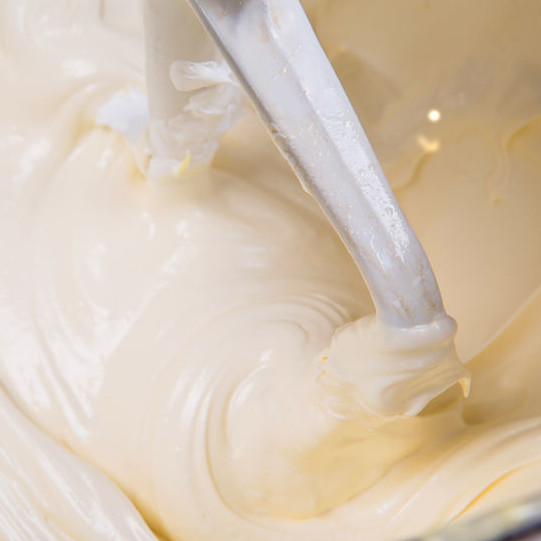Acetylated Monoglycerides (AMG)
What are Acetylated Monoglycerides (AMG)?
Acetylated monoglycerides (AMG) are non-ionic surfactants widely used in baking and other food formulations. Chemically, they are acetic acid esters of monoglycerides whose properties depend on the composition of the monoglyceride and the degree of acetylation.
Various food systems use acetylated monoglycerides, such as:
- Bakery products (cakes)
- Desserts
- Non-dairy creamers
- Toppings
Origin
Similar to other synthetic emulsifiers, AMG invention was driven by the food industry’s need for functional substitutes for tallow and hydrogenated fats. It was developed by the interesterification of edible fats with triacetin in the presence of catalytic agents. Or, by direct acetylation of edible monoglycerides with acetic anhydride without the use of catalyst. The chemical structure of acetylated monoglycerides is a follows:2

Commercial production1
AMG can be synthesized through the interesterification of edible fats with triacetin in the presence of a catalyst. It can also be prepared by the acetylation of monoglycerides and acetic anhydride without the need for catalysts.
Function
AMG is a nonionic and fat soluble surfactant. The stable alpha crystalline structure of AMG is responsible for its emulsifying properties mainly at higher temperatures. It is also the basis for its application in specialty fats, toppings, whippable emulsions, or cake mixes.2
Emulsifying activity of AMG is based on:3
- Its stability even when heated to 97.7 °C (207 °F) for 1,000 hrs
- It acts as a solvent, lubricant and plasticizer because it’s liquid at low temperatures
In addition, AMG performs other functions in foods:4
- Stabilizes lipid components and prevents separation
- Improves food texture and consistency
- Extends shelf life of products
- Thickens foods
- Strengthens dough
- Enhances food flavor
- Acts as a coatings to retard dehydration of fruits
- Provides antioxidative activity
AMG has low polarity and hydrophilic–lipophilic balance (HLB) of 1.5 indicating low emulsifying capacity.
Application
In baked goods, mainly cakes, AMG is typically added to the liquid phase or batter.
Its use in whipped cream, fillings and frostings can help stabilize and extend their shelf life. In vegetable fat-based creams, AMG improves the whipping and foaming properties.
Emulsifying properties of AMG are improved when combined with other surfactants.
FDA Regulation
AMG is GRAS and can be used safely in or on food if its manufacturing and the content of non-fat components meet the FDA requirement under 21CFR172.828. 1
References
- U.S. Food & Drug Administration. “21CFR172.828 – Code of Federal Regulations Title 21.” Accessdata.fda.gov, 1 Apr. 2017, www.accessdata.fda.gov/scripts/cdrh/cfdocs/cfcfr/CFRSearch.cfm?fr=172.828. Accessed 31 Aug. 2017.
- Acetylated Monoglycerides Market: Global Industry Trend Analysis 2013 to 2018 and Forecast 2018-2026. https://www.persistencemarketresearch.com/market-research/acetylated-monoglycerides-market.asp. Last accessed by Dec 24. 2019.
- Gunstone, F.D., and F.B. Padley. “Food Emulsifiers.” Lipid Technologies and Applications, Marcel Dekker, 1997, p. 527.
- Kinds of Emulsifiers.https://www.rikenvitamin.com/foodingredients/emulsifier/kind.html#amg. Last accessed by Dec 24. 2019.


